
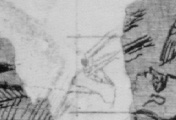
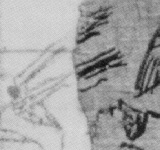
Back to Mormonism Researched Page
On Thumbs & Wings & Other Things
Research by Kerry A. Shirts
When the Papyri that Joseph Smith had possessed in the 1830's came back into the possession of the Church of Jesus Christ of Latter Day Saints in 1967, little did any of us realize just how long and hard drawn this battle would be. We never figured the critics would be so persistent at presenting their arguments. We never believed that they would keep presenting their arguments even after they were effectively refuted from thorough and sound research. Yet they persistently argue from the same stance in the 1960's, right up to our day here in the 1990's. But a lot of water has gone under the bridge since the 1960's, and if critics insist on resurrecting their dead horse arguments, we can hardly be accused of beating the dead horse if they won't bury it and move on to more substantial issues. So, it is up to us Mormons to bury the horse once and for all.
The Egyptologist Richard Parker, on examining the original Facsimile #1 in the Book of Abraham, the Lion Couch, said, among other things, "The apparent upper hand is part of the wing of a second bird which is hovering over the erect phallus of Osiris (now broken away)."1 Hugh Nibley very effectively refuted this assertion in his articles in the Improvement Era.2 It is indeed ironic, that though the second bird theory was annihilated, that the most current anti-Mormon discussion, Charles Larson, By His Own Hand Written Upon Papyrus, reconstructs the lion couch scene and that with a second bird hovering over the middle!3



Above left is the original Facsimile 1. It was not a complete copy with the rather obvious lacuna (gap) in the center. The middle picture is a closer look. The right is a closer look still at the critical area we are discussing. Below I circle the areas that Parker, Nibley, and Larson have discussed and redrawn (in Larson's case).
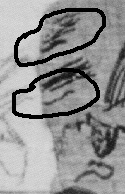 The
upper part circled is what Parker felt was the wing of a second
bird, and which Larson redrew to be a second bird. Nibley
contended that these were the remains of two drawn hands, also
acknowledging that the pencilled part was not the Mormons doing
so. The issue is simple. Is the reconstruction of Larson, or
Joseph Smith more accurate in light of ancient Egyptological
artistic workings.
The
upper part circled is what Parker felt was the wing of a second
bird, and which Larson redrew to be a second bird. Nibley
contended that these were the remains of two drawn hands, also
acknowledging that the pencilled part was not the Mormons doing
so. The issue is simple. Is the reconstruction of Larson, or
Joseph Smith more accurate in light of ancient Egyptological
artistic workings.
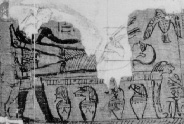
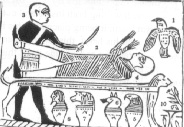
So, the way to resolve the difficulty is honestly quite simple. Oh it takes some serious researching through Egyptian literature and other works, but the question is, are those two areas thumbs or wings? In order to see which they are, we of course, look up the way the Egyptians drew thumbs and wings. Hugh Nibley already did this in his Improvement Era articles, though he did not present pictures. What I will do is present a pictorial essay, so to speak, in order to see which fits better thumbs, or wings. This is something that critics simply will not do, nor have done, yet it is the logically correct approach. The interesting thing here is that Larson claims his reconstruction is "based on the modern study of Egyptology, and similar scenes in numerous existing papyri."4 He also claims that "A professional reconstruction" is what this is.5 Now this is interesting! Professional? Who drew it? Larson does not say. We, quite frankly, find this impossible to believe based on the literally thousands and thousands of Egyptological pictures we have perused, and present here below, though but a small fraction of the availability, which we will present in the Endnotes. Larson is pulling our legs. I know of absolutely no Egyptologist who would agree with Larson. Perhaps, since Stephen Thompson endorses Larson's woefully inadequate book, he was the one who redrew this? If so, why not say so? No, it is time to look at the available evidence and show why Larson is not kidding anyone.
The one glaring gap in Larson's research is the lack of utilizing Erik Iversen's landmark study, and the keynote study to any and all discussion concerning Egyptian art and how they drew human figures.6 As we demonstrate, it is no wonder Larson let this one slip. Iversen notes that according to canonical proportions, the Egyptians frequently drew an unusually prominant thumb. See below.
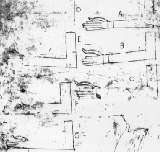
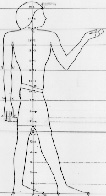
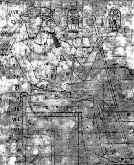
These thumbs are very clearly and obviously thumbs. Their curve is unmistakable as is their relation to the hands, with the Egyptian artistic styles in mind, of course. When we compare these to the original Facsimile #1, it screams THUMBS!
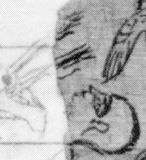 The
curve of the thumbs is indeed, very obvious. And in fact, the
upper one has been drawn in extra heavily emphasizing this is a
human thumb. The lower one is unquestionably a thumb, and it has
the exact same back-curve which thumbs have, and which is
exhibited in the top hand also. Now when we look at other
Egyptological materials we see this exact same phenomenon in
Egyptian art lending strength to our proposition of thumbs, not
wings, prominantly drawn, many with that very distinctive
backward curve, as thumbs do have.
The
curve of the thumbs is indeed, very obvious. And in fact, the
upper one has been drawn in extra heavily emphasizing this is a
human thumb. The lower one is unquestionably a thumb, and it has
the exact same back-curve which thumbs have, and which is
exhibited in the top hand also. Now when we look at other
Egyptological materials we see this exact same phenomenon in
Egyptian art lending strength to our proposition of thumbs, not
wings, prominantly drawn, many with that very distinctive
backward curve, as thumbs do have.
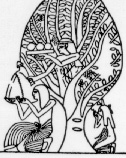 (in Kurt
Sethe, Urgeschichte und Alteste Religion der Agypter, Leipzig,
1930, p. 27)
(in Kurt
Sethe, Urgeschichte und Alteste Religion der Agypter, Leipzig,
1930, p. 27)
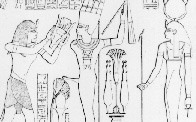 (in C.J.
Bleeker, Die Geburt eines Gottes: Eine Studie Uber den
Agyptischen Gott Min ind sein Fest, Leiden, E.J. Brill,
1956, Fig. 1)
(in C.J.
Bleeker, Die Geburt eines Gottes: Eine Studie Uber den
Agyptischen Gott Min ind sein Fest, Leiden, E.J. Brill,
1956, Fig. 1)
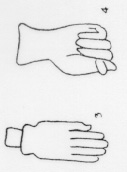
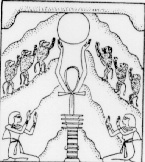
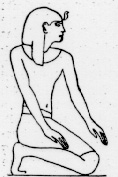 (in Hans Bonnet, Reallexikon
der Agyptischen Religionsgeschichte, de Gruyter, 1952, pp.
28, 732, 207 respectively)
(in Hans Bonnet, Reallexikon
der Agyptischen Religionsgeschichte, de Gruyter, 1952, pp.
28, 732, 207 respectively)
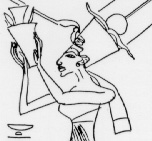
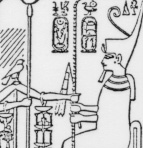

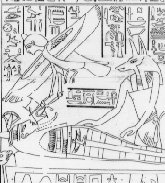
1st above, - Julia Sampson, "Nefertiti's Regality," in Journal of Egyptian Archaeology, 1977, p. 93. 2nd from left, Kate Bosse-Griffiths, "The Great Enchantress in the Little Golden Shrine of Tutankhamun," in Journal of Egyptian Archaeology, 1973, p. 106. Also see pp. 104, and plates XXXV, XXXVI. 3rd from left, Kate Bosse-Griffiths, "A Beset Amulet From the Amarna Period," in Journal of Egyptian Archaeology, 1977, p. 103. Notice the extra large and long thumbs, exactly like in the Joseph Smith Facsimile #1! 4th from left, Nine M. Davies, "Some Representations of Tombs From the Theban Necropolis," Journal of Egyptian Archaeology, 24(1938), p. 30. NOTICE THE WINGS! They are one single unit, as opposed to the obvious thumbs on Anubis, as well as that Ba bird.

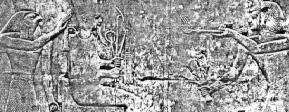
Left, Robert Hari, "Le Grande-en-Magie et la Stele du Temple de Ptah a Karnak," in Journal of Egyptian Archaeology, 1976, plate XIV a. To the right, Sh. Yeivin, "Canaanite Ritual Vessels in Egyptian Cultic Practices," in Journal of Egyptian Archaeology, 1976, plate XV.
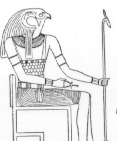


left top, Adolf Erman, Die Religion der Agypter, de Gruyter, 1934, p. 26. See also pp. 15, 17, 32, 37, 45. middle panel, S. Schott, "Falke, Geier, und Ibis als Kronungsboten," in Zeitschrift fur Agyptischen Sprache, hereafter ZAS, 1968, Tafel IX. far right, Wilhelm Spiegelberg, "Die Falkenbezeichnung des Verstorbenen in der Spatzeit," in ZAS, 1927, p. 28. See also p. 29.
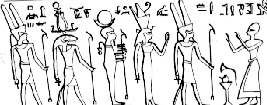
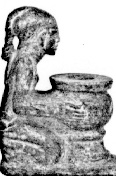
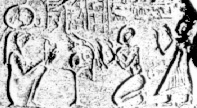
left above, M.I. Bakr, "Amon, der Herdenstier," in ZAS, 1970, p. 1. See p. 3 also. Middle panel, Elizabeth Staehelin, "Zur Hathorsymbolik in der agyptischen Kleinkunst," in ZAS, 1978, behind p. 80. Far right, W. Wreszinski, "Das Buch vom Durchwandeln der Ewigkeit nach einer Stele im Vatikan," in ZAS, 1908, Tafel V, upper right hand corner.
These few instance determine once and for all how thumbs are drawn. The thumbs I circled above in the JS Fac. #1 are like these thumbs from Egyptian documents, thus determining these are thumbs in the JS Fac. #1. But another angle we can take is to look at wings, specifically wings in other lion couch scenes.
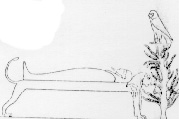
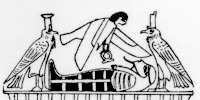
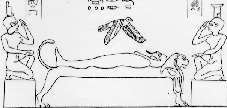
The left above from Ph. Derchain, in Chronique D' Egypte, 34(1959), p. 74. The middle panel, from "Notes et Remarques", in Recueil de Travaux Relatifs, 1955, p. 125. The far right panel from Lanzone's Dizionario Mitalogia Egizia, (hereafter cited as DME) 1885, Tav. CCLXXX. Note the wings on birds over the lion couch and mummy are a single unit, not separate feathers as Larson incorrectly restored.
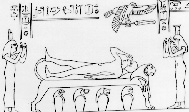


Left above, DME, Tav. CCLXXXI. Middle panel, DME, Tav. CCLXXVI. Right panel, E.A.W. Budge, Gods of the Egyptians, Dover, 1969, p. 137. Notice again, sometimes there is only one bird, sometimes three birds, sometimes two birds, but in every single instance that we are aware of their feathers are ***never*** separated as Larson incorrectly restored his version of JS Fac. #1. In fact, in all the other lion couch scenes we are aware of, there is never a bird drawn with wings like Larson draws.7
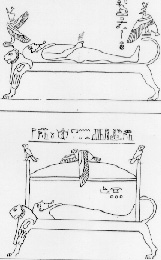
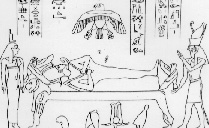
Both from Lanzone's DME, plates CCLXXII, and CCLXX. Again note the wings are not separated feathers at all, but all together, not separate fingers as in the JS Fac #1. And no bird in the middle above the figure is ***ever*** in the position that Larson draws. It is nowhere even near like that at all in ***any*** lion couches we have seen in the reference #7 below.
So Larson misses on both counts. His bird is incorrectly placed as evidenced by other lion couch scenes here which show how the birds are placed, and his wings are grossly incorrect by Egyptian standards of drawing wings. And the second part that Larson muffed it on was ignoring both thumbs on the hands in the JS Fac #1, which we have clearly seen. In fact, the Egyptian literature is so chock full of drawings of hands and thumbs, as to be an almost embarrassing amount of riches to pursue were one more serious than Larson and other critics are on this papyri issue. They have never really done the real homework that it takes in order to determine much on anything. All they want to do is arrive at quick negative conclusions without eliciting much evidence to back their claims. The more we look into the Egyptians themselves, the more confirmed Joseph Smith is. For instance, you won't see many of the sources in the following footnote that critics use. They have to keep their research to a minimum in order to arrive at the negative conclusions they do, yet the sources listed in footnote eight also establish that Joseph Smith was correct in putting two hands with bold thumbs in Fac. 1 as opposed to another bird.8 The critics, such as Charles Larson in his latest attempt in the 1990's, are still doing irresponsible research. The overwhelming consensus of Egyptian art clearly demonstrates Joseph Smith was correct in drawing thumbs on two hands in the air in his Facsimile #1 in the Book of Abraham. In fact, it is staggering there is so much to see, and yet critics maintain the wings concept. I, for one, would like to see just how they justify this restoration in light of all the abundant evidence from the Ancient Egyptians themselves.
Endnotes
1. Richard Parker, "The Joseph Smith Papyri: A Preliminary Report," in Dialogue: A Journal of Mormon Thought, Aug. 1968, p. 86.
2. Hugh Nibley, "A New Look at the Pearl of Great Price," in Improvement Era, Oct-Dec. 1968.
3. Charles Larson, By His Own Hand Written Upon Papyrus, Institute for Religious Research, Revised edition, 1992, p. 65.
4. Larson, Ibid., p. 65.
5. Larson, Ibid., p. 62.
6. Erik Iversen, "A Canonical Master-Drawing in the British Museum," in Journal of Egyptian Archaeology, 46(1960), pp. 71-79.
7. Budge, Gods, pp. 137, 136, 134f, 132f, 131; Budge, Osiris, 2 vols., Dover, 1973, 2nd vol., pp. 22-35, 38-43, 45-54, 56. Lanzone's DME, plates, 30, 63f, 261 (3 scenes), 262, 265, 268-271, 272 (2 scenes), 273f, 276f, 277-291. Journal of Egyptian Archaeology, 1918, p. 143, 1931, plates 56f, 1938, p. 30, fig.9. Chronique D' Egypte, 1943, pp. 195-97, figs. 27fff, 1959, p. 74, fig. 5, etc., etc.
8. Wolfhart Westendorf, "Die geteilte Himmelsgottin," in Gegengabe Festschrift fur Emma Brunner-Traut, Verlag Tubingen, 1992, p. 342f, 347, 351 (another lion couch!); Gunther Holbl, "Agyptische Kunstelemente im phonikischen Kulturkreis des 1. Jahrtausends v. Chr.: Zur Methodik ihrer Verwendung," in Orientalia, 58(1989), p. 319, 323, showing thumbs and wings together with the thumbs clearly separated.Noel Aime-Giron, "Adversaria Semitica," in Annales du Service Des Antiquities de L' Egypte, Vol. 42, p. 293, 305, 309, 310; Alan Gardiner, "The Baptism of Pharaoh," in Journal of Egyptian Archaeology, 1950, plates 1 and 2; W.M. Flinders Petrie, "Egyptian Beliefs in a Future Life", in Ancient Egypt, 1914-15, pp. 19, 21, (another lion couch scene), 24, 27, 28 (thumbs even on stick figures); Adolf Rusch, Die Entwicklung der Himmelsgottin Nut zu einer Totengottheit, J.C. Hinrichs'sche Buchhandlung, Leipaig, 1922, p. 37; Klaus Koch, Geschichte der agyptischen Religion, Stuttgart Berlin Koln, 1993, pp. 68, 575f, 581, 583, 585; Hans Bonnet, Reallexikon der Agyptischen Religionsgeschichte, de Gruyter, 1952, pp. 12, 14, 28, 96, 141, 151 (thumbs on stick figures!), 205, 207, 303, 317, 358, 361, 383 (another lion couch scene), 387, 397ff, 428, 458, 505, 638, 732, 739, 741, 755; Erik Hornung, Der Agyptische Mythos von der Himmelkuh, Universitatsverlag Freiberg Schweiz, 1982, pp. 82, 86, 99f; Lanzone's DME, Tavs, CCXXIX, CLXXIX, CLXXX, CCLXXXIX, CCXCI, CCLXXXVII, CCLXXXVIII, LXII; Sigfried Morenz, Gott und Mensch im alten Agypten, Leipzig, 1984, p. 181 (Anubis mask); Heike Sternberg El Hotabi, "Die Mensa Isiaca und die Isis-Aretologian," in Chronique D' Egypte, 1994, pp. 56, 69f, 84; Receuil de Travaux Relatifs, 1867, p. 146; Chronique D' Egypte, July 1943, figs. 28-30; Reinhold Merkelbach, "Diodor uber das Totengericht der Agypter," in ZAS, 1993, pp. 72, 75-77, 80; G.A. Wainwright, The Sky Religion in Egypt, Cambridge Univ. Press, 1938, p. 46f; Adolf Erman, Die Religion der Agypter, de Gruyter, 1934, pp. 15, 17, 26f, 32, 34, 37, 45; Gertie Englund, "God as a Frame of Reference," in The Religion of the Ancient Egyptians, Uppsala Symposium, 1989, pp. 16f; Jorgen Podemann Sorenson, "Divine Access," in Ibid., pp. 112, 119f; Erik Iversen, "A Canonical Drawing in the British Museum," in Journal of Egyptian Archaeology, 1960, plate XVI, p. 72, 73; Erik Hornung, Valley of the Kings, Timken Publishers, 1982, pp. 57 (a lion couch scene), 58, 66, 135, 137, 143, 146 (many lion couch scenes); Christine Hobson, The World of the Pharaohs, Thames & Hudson, 1987, p. 119; Lionel Casson, "Ancient Egypt," in Time Life Books, 1965, lion couch scene showing bird with single wing feathers, not individual as Larson portrays; Georges Posener, A Dictionary of Egyptian Civilization, Methuen & Co., Ltd., 1962, p. 60, (lion couch scene), 175, 192f; Christiane Desroches-Noblecourt, Tutankhamun, N.Y. Graphic Society, 1977, p. 258 wooden statue of King Tut, excellent thumbs, also note the one bird with a hawks' head, and the other with a human head; I.E. S. Edwards, Tutankhamun: His Tomb and its Treasures, Knopf Inc., 1976, pp. 104f ***EXCELLENT THUMBS***; John Baines, Atlas of Ancient Egypt, Facts on File, 1980, p. 118 (lion couch scene on mummy); The Mastaba of Mereruka, pt. 1, Univ. of Chicago, Sakkarah Expedition, 1938, plate 94; Richard Parker, Jean Laclant, Jean-Claude Goyon, The Tomb of Nefer-Hotep, Brown Univ. Press, 1979, plate 23; Norman DeGaris Davies, The Tomb of Nefer-Hotep at Thebes, Arno Press, N.Y., 1973, plates XXXIV; Epigraphic Society, Medinet Habu VI, Univ. of Chicago Press, 1963, plate 426B; Medinet Habu, Vol. VII, 1964, plate 494; Medinet Habu: Astronomical Ceiling of the Sanctuary of Osiris, 1963, plate 476, 478; Robert Lawlor, Sacred Geometry, Thames & Hudson, reprint, 1994, pp. 60, 89, 94; Ralph Burns, World Civilizations, W.W. Norton Co., 6th printing, 1982, pp. 31f, 40f, 43f; Monica Sjoo & Barbara Mor, The Great Cosmic Mother, Harper & Row, 1987, p. 255; Ann Baring & Jules Cashford, The Myth of the Goddess, Penguin Books, 1993, pp. 229, 233, 236f, 243f, 250f, 258, 261ff, 267; Sabatino Moscati, The Face of the Ancient Orient, Doubleday, 1962, plate XXI; Raphael Patai, The Hebrew Goddess, 3rd ed., Wayne State Univ. Press, 1990, plate 25, 29; Georgio Santillana & Hertha von Dechend, Hamlet's Mill, Nonpareil Books, reprint, 1992, plate between pp. 162-63; Carl Jung, Psychology and Alchemy, Princeton Univ. Press, 8th ed., 1993, pp. 135, 139; Alan Gardiner, Egypt of the Pharaohs, Oxford Univ. Press, 1964, pp. 82, 86, 118, 215, 219f, 229f, 267, 402f; Alan Gardiner, Egyptian Grammar, Griffith Institute Ashmolean Museum, Oxford, 3rd ed., 1994, pp. 7, the hieroglyph shows the thumb, also p. 27, sign-list, p. 453, #'s 28-30, 32, p. 454, #'2 35f, p. 455, #'s 41f, 46f, p. 456, # 49, p. 449. #11, p. 448, #'s 2f; Robert Bauval, The Orion Mystery, Crwon Publishers, 1994, pp. 93, 76, plates 15b, 13b; Graham Hancock, Robert Bauval, The Message of the Sphinx, Crown Publishers, 1996, pp. 159, 177, 181, 213, 275, 277, 279; I.E.S. Edwards, The Pyramids of Egypt, Penguin Books, Revised, 1993, plates 5, 9, 22, 48; John Anthony West, Serpent in the Sky, First Quest Books, 1993, pp. 3, 8, 39, 81ff, 85ff, 89, 101, 134, 159f, 163, 171, 173, 176fff; C.W. Ceram, Gods, Graves, and Scholars, Bantam Books, 1972, plates VIII; Jack Lindsay, A Short History of CUlture, Fawcett Premier, 1966, p. 197, 202, 210, 219f; Cheikh Anta Diop, Civilization or Barbarism, Lawrence Hill, 1991, pp. 299fff; Michael A. Hoffman, Egypt Before the Pharaohs, Barnes & Noble, 1993, p.314; Joseph Campbell, The Power of Myth, With Bill Moyers, Doubleday, 1988, pp. 38, 164, 176, 178; Joseph Campbell, The Hero With a Thousand Faces, Princeton Univ. Press, 3rd printing, 1973, pp. 111, 209, 283, 291, 298, 341, 369, 372; Joseph Campbell, The Mythic Image, Princeton Univ. Press, 1st paperback, 1981, pp. 16, 20f, 22, 24, 25-29, 31; Joseph Campbell, Transformations of Myth Through Time, Harper & Row, 1990, pp. 78f, 83, 85, 89; George Steindorff, Keith C, Seele, When Egypt Ruled the East, Univ. of Chicago Press, 2nd printing, 1957, pp. 27, 49, 61, 68, 73, 76, 81, 99, 103, 133, 136, 138, 145, 153f, 172fff, 180f, 183-186, 202, 208, 229, 238, 249f, 263, 266; Karl Theodor Zauzich, Hieroglyphs Without Mystery, 2nd printing, Univ. of Texas Press, 1994, pp. 54, 68, 71, 77, 84; Geoffrey Parrinder, World Religions: From Ancient History to the Present, Facts on File, 1971, 132, 133, 134; Paul A Laviolette, Beyond the Big Bang, Park Street Press, 1995, pp. 328, 209, 188, 141, 127, 122, 114, 107, 23; Lewis Spence, Egypt, Studio Editions, Senate Press, 1994, pp. 54, 80f, 88, 118, 153;Leonard Cottrell, Egypt, Oxford Univ. Press, 1966, pp. 16, plates 31-34, plate 53, 57f, 62, 66, 72, 87-89, 102, plate next to pg. 174, plate 109f, 112, 114-117, 119, plate next to page 204, plate 123, 126, 128f, 138 Note the thumbs compared to the wings on the same pillar, 149, 151, plate across from p. 269; Hilary Wilson, Understanding Hieroglyphs, Passport Books, 1995, pp. 20, 25, 45 see the wings compared to the thumbs here also, 57, 76f, (wings), 91, 93, 97, 100, 103, 107, 116, 135, 140, 148, 151f, 155, 161, 167; W.V. Davies, Reading the Past: Egyptian Hieroglyphs, Univ. of California Press, 5th impression, 1993, pp. 15f, 18, 39 (Narmer Palette); Torgny Save-Soderbergh, Pharaohs and Mortals, Barnes and Noble, 1996, pp. 229, 123, 91, 85, 22; E.C. Krupp, Echoes of the Ancient Skies, Harper & Row, 1983, pp. 212, 106; Graham Hancock, Fingerprints of the Gods, Crown Publishers, 1995, plates 61 and 61 in front of page 487, also plate 55; David Fideler, Jesus Christ: Sun of God, Quest Books, 1993, pp. 255, 263; Margaret Bunson, Encyclopedia of Ancient Egypt, Facts on File, 1991, pp. 12f, 20f, 24-27, 39, 68f, 80, 85f, 90, 96f, 105, 108, 111, 116, 118ff, 123f, 126, 129, 137, 140, 150, 153, 162, 165, 173, 179, 185, 197, 215, 222, 226f, 238, 240f, 244, 250, 264; Peter Tompkins, Secrets of the Great Pyramid, Harper & Row, 1971, pp. 171, 178, 194; Francis Huxley, The Way of the Sacred, Bloomsbury Books, 1989, pp. 33, 140; R.O. Faulkner, The Ancient Egyptian Book of the Dead, Univ. of Texas Press, 2nd printing, 1993, absolutely every plate with a human figure shows the prominant and sometimes oversized thumbs! There are easily 45 vignettes here to look at; Adolf Erman, Life in Ancient Egypt, Dover, 1971, pp. 398f, 233, Cf. bird's wings 446, 478, back to thumbs on p. 237, 305, 30, 33, 46f, 49, 51, 59, 61ff, 65, 68, 75ff, 86, 93, 95, 99ff, 103f, 108f, 112, 120, 139, 176, 181, 183, 187, 191, 199, 201-217, cf. more wings, p. 28, 53, 235, back to thumbs, p. 247-258, 268-271, 264, 276, 282f, 296, 321, 347ff, 410-406, 408, 410, 414f, 421, 425, 431, 442, 464, 501, 518, 532; Veronica Ions, Egyptian Mythology, Hamlyn Publishing, 2nd impression 1973, pp. 10, 18 (SUPERB thumbs, exactly like in the JS Fac. #1), pp. 26-30, 33f, 43, 51ffffff, 59, 73 (Perfect thumbs); T.G.H. James, The Archaeology of Ancient Egypt, Henry Z Walck, 1972, pp. 15, 18, 48f, 90; The Book of the Dead: Famous Egyptian Papyri, Papyri of Ani, Hunefer, Anhai, British Museum, no date, pp. 8, 13, 15, 19, 25-41, 50ff, 58fff, 65, 68, 70, 74f, 80-88, 99-113, 117.